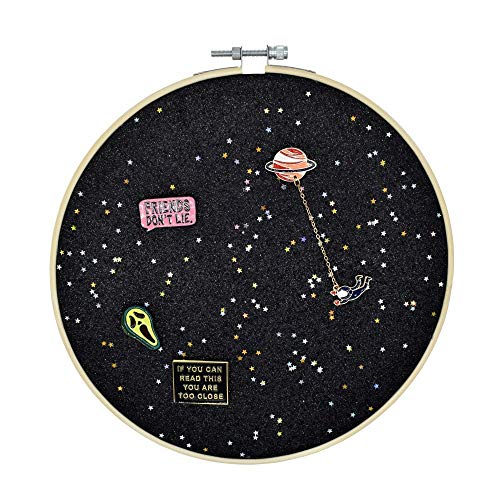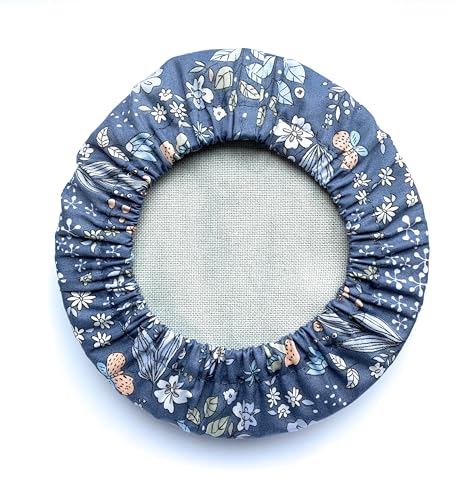Embroidery Hoop Size Guide
Please select a hoop size to see the details.
Embroidery Hoop Size Guide: Choosing the Right Hoop for Your Project
Embroidery is an age-old craft that has captured the hearts of many. Whether you’re creating intricate patterns for a wall hanging or simple designs for a clothing piece, embroidery is an art form that allows for endless creativity. But as with any craft, using the right tools is crucial for achieving the best results. One such tool that every embroiderer needs is the embroidery hoop.
Embroidery hoops come in a variety of sizes, and choosing the right one for your project can make a significant difference in both the ease of your work and the quality of your final design. We’ll break down everything you need to know about embroidery hoop sizes, including how to choose the right size for different projects and how to properly use an embroidery hoop.
What is an Embroidery Hoop?
An embroidery hoop is a circular frame that holds the fabric taut while you work on your embroidery. The hoop is designed to stretch the fabric evenly and keep it in place, ensuring that your stitches are smooth and consistent. Without a hoop, it would be difficult to keep the fabric tight enough to stitch properly, and your design could become distorted.
Embroidery hoops are typically made from wood, plastic, or metal, with two parts: the outer hoop and the inner hoop. The fabric is placed between the two hoops, and the outer hoop is tightened around the fabric to keep it stretched.
Understanding Embroidery Hoop Sizes
Embroidery hoops come in various sizes, ranging from small 3-inch hoops to larger ones that can exceed 12 inches. The size of the hoop you use depends on the size of your project and the area you need to embroider.
Here are some key considerations when choosing an embroidery hoop size:
- Design Size: The larger your design, the larger your hoop will need to be. This ensures you have enough space to complete the design comfortably.
- Fabric Type: Some fabrics may require a larger or smaller hoop. For example, delicate fabrics may need a smaller hoop to avoid damage, while sturdier fabrics may allow for larger hoops.
- Stitch Type: If you’re working on a project that requires a lot of intricate stitches, a smaller hoop can give you better control over the design.
- Comfort: Some embroiderers prefer to work with smaller hoops for better control, while others may opt for larger hoops for ease of stitching.
How to Choose the Right Embroidery Hoop Size
Choosing the right size hoop for your project involves considering the following factors:
- Project Size: For smaller, detailed designs, a smaller hoop (4-6 inches) is ideal. Larger designs, especially those that cover a substantial portion of the fabric, require larger hoops (8-12 inches). When choosing a hoop, ensure that the design fits comfortably within the hoop with a little extra fabric around the edges.
- Fabric Type and Weight: Lightweight fabrics, such as linen or cotton, work well with most hoop sizes. However, for heavier fabrics like denim or canvas, you may need a larger hoop to ensure the fabric stays taut while you work. For fabrics that are delicate or prone to stretching, you may want to use a smaller hoop to minimize the risk of damaging the material.
- Type of Stitching: If you’re working on a project with heavy stitch work, such as cross-stitching or thread painting, you might find it easier to work with a medium-sized hoop (6-8 inches). This size allows for enough space to maneuver the needle without making the fabric too tight.
- Level of Detail: For projects with finer, more intricate details, such as monogramming or delicate floral designs, smaller hoops provide more precision and control. The tighter you pull the fabric in a smaller hoop, the better you can achieve the crisp, detailed stitching needed for these types of designs.
- Comfort: If you plan on spending long hours stitching, consider the comfort factor. Larger hoops may be less comfortable for some embroiderers to hold for extended periods, whereas smaller hoops may feel more manageable. The size of the hoop also affects how much fabric you need to move around as you stitch.
Common Embroidery Hoop Sizes and Their Uses
Embroidery hoops come in several common sizes. Here’s a breakdown of the sizes and what they are typically used for:
| Hoop Size | Diameter | Common Uses |
|---|---|---|
| 3-inch | 7.62 cm | Ideal for small, intricate designs such as monograms or small motifs. Perfect for quick, detailed projects. |
| 4-inch | 10.16 cm | Great for small to medium-sized designs like small flowers or animal motifs. Works well for projects like handkerchiefs and small patches. |
| 5-inch | 12.7 cm | Suitable for small embroidery projects or beginner-level designs. It’s perfect for basic stitch work and allows enough space for neat work on smaller fabric areas. |
| 6-inch | 15.24 cm | One of the most commonly used hoop sizes. Ideal for medium-sized designs like larger floral patterns, geometric shapes, and embroidery for clothing such as shirts or skirts. |
| 7-inch | 17.78 cm | Perfect for medium to larger embroidery designs. Works well for projects that require more space for large motifs, such as embroidery for pillowcases, towels, or wall art. |
| 8-inch | 20.32 cm | Often used for larger designs, especially if you need more space for detailed stitching. This size is commonly used for hand embroidery on larger pieces of fabric like large tapestries, blankets, or wall hangings. |
| 10-inch | 25.4 cm | Best for large projects or designs that cover a significant portion of the fabric. This size is useful for larger tapestries, elaborate floral designs, or large monogrammed pieces. |
| 12-inch | 30.48 cm | The largest standard size hoop. Ideal for very large projects, such as full-length tapestries, embroidered quilts, or extensive large-scale designs. |
Benefits of Different Hoop Sizes
Each embroidery hoop size has its own set of advantages. Here’s how different sizes can benefit you:
- Small Hoops (3-5 inches): These hoops are ideal for fine, detailed designs. They’re especially useful for beginners as they help you concentrate on smaller areas and refine your stitching technique. They are also great for compact projects like bookmarks, patches, and small artwork.
- Medium Hoops (6-8 inches): A versatile size that can handle a wide range of designs, from medium floral patterns to logos. These hoops are large enough to accommodate intricate stitching but small enough to be easy to manage. This size is often the go-to for projects like handkerchiefs, pillowcases, or smaller sections of a garment.
- Large Hoops (10-12 inches): These larger hoops are perfect for bigger designs, such as large wall hangings, quilts, or intricate projects that span large areas of fabric. These hoops are designed for those who like to work on bigger projects and need plenty of space to maneuver their needle comfortably.
Tips for Using an Embroidery Hoop
- Ensure the Fabric is Taut: When placing fabric in the hoop, make sure it is stretched tightly to prevent puckering or uneven stitches. This will also help you achieve clean, smooth stitches.
- Choose the Right Tension: Too much tension can cause the fabric to distort, while too little can make the fabric floppy. Find the right balance to keep your fabric firm but not overly stretched.
- Use a Hoop Stand: For larger hoops, you may want to use a hoop stand to keep your hands free and reduce strain. A stand can hold your hoop securely in place while you stitch, which is especially helpful for bigger projects.
- Rotate the Fabric: If you’re working on a large project with a small hoop, you may need to reposition the fabric periodically to access all areas of your design. Rotate the fabric to avoid using the same part of the hoop for extended periods.
- Clean the Hoop: Wooden hoops can accumulate dust and oils from your hands, so be sure to wipe them clean regularly. Plastic and metal hoops can be cleaned with a damp cloth.
Conclusion
Choosing the right embroidery hoop size is crucial for ensuring a successful and enjoyable stitching experience. By understanding how different hoop sizes affect your project, you can choose the one that fits your design, fabric, and stitching needs. From delicate, intricate patterns to large, detailed artworks, there’s a hoop size out there for every embroidery project.
Whether you’re a beginner or a seasoned embroiderer, having the right tools, including the appropriate embroidery hoop, will help you create beautiful, precise designs with ease. With the right size hoop in hand, you’re ready to tackle any embroidery project that comes your way.






